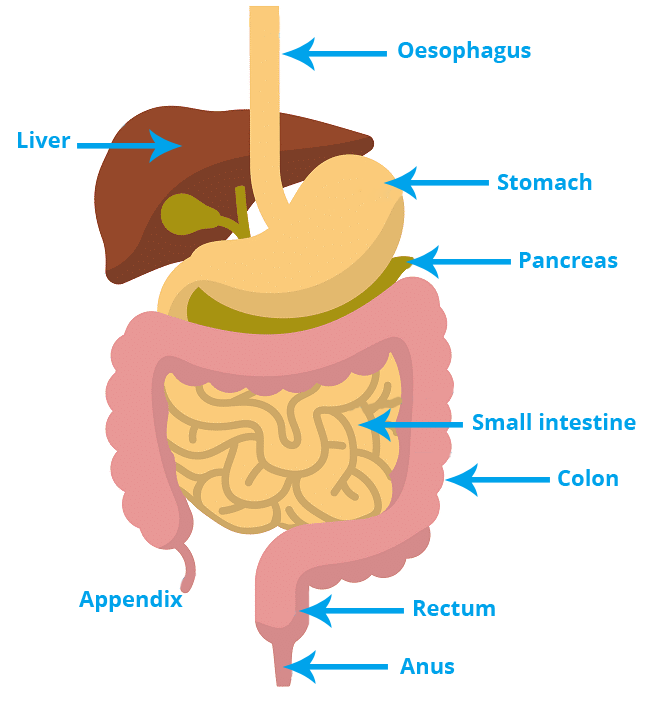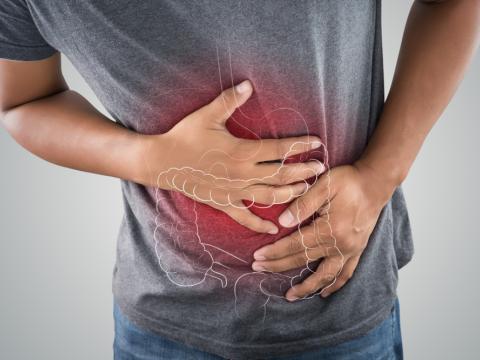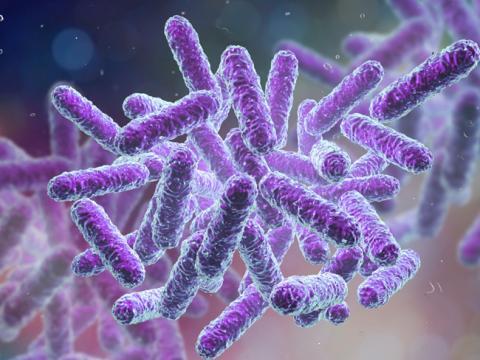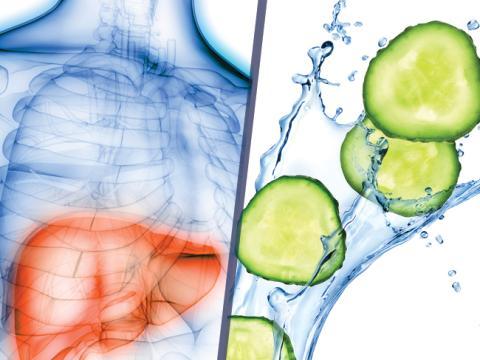The digestive system

Œsophagus
This muscular tube transfers food by peristalsis (or rhythmic “squeezing”) from the pharynx to the stomach. It is about 25 cm long and 2 cm in diameter.
At both ends, it is sealed by sphincters (circular muscles). These sphincters relax to open and allow food to pass through, and then close to prevent any reverse flow.
The liver and the biliary system
The liver is the largest internal organ in the human body and weighs about 1.5 kg. It accounts for 2.5 % of total body weight. The liver and biliary system produce bile, a fluid which aids digestion, particularly the digestion of fats.
The body produces about 1 litre of bile every day, half of which flows directly into the small intestine, with the other half stored in the gallbladder, primarily during the night.
Stomach
The stomach is a digestive “bag”, located in the upper left-hand part of the abdominal cavity, which expands or contracts depending on how much food it contains. It is composed of four sections: the cardia, fundus, body (the largest part) and the pylorus which links to the first section of the small intestine, called the duodenum. Iron and fat-soluble molecules (such as alcohol and some medicinal products) are absorbed in the stomach. Peristalsis mixes the food with enzymes and hydrochloric acid (synthesised by the gastric glands, located in the stomach wall) and transfers the resulting liquid (called “chyme”) to the small intestine.
The vagus nerve and the sympathetic nerve system control both gastric secretions and the stomach’s motor activity.
Since we are now aware of the links between the gut and the brain, we better understand why, when we are stressed, our digestion is affected.
Pancreas
The pancreas is an organ of both the digestive system and of the endocrine system, and is located behind the stomach, in the upper part of the abdomen. The pancreas secretes digestive fluids containing enzymes into the duodenum (the first section of the small intestine) to help to break down the food into simpler compounds which can be absorbed by the intestine. The pancreas also secretes insulin, which passes into the blood to maintain a suitable blood glucose level.
Colon
The colon, or large intestine, is the final organ in the digestion process. It removes water from the non-digestible fraction of the food consumed by a process of absorption. The end result is faeces that can be eliminated from the body. The colon is about 1.5 metres long, and is made up of 6 distinct sections. Starting at the junction with the small intestine, these are: the caecum, ascending colon, transverse colon, descending colon, sigmoid colon and rectum.
Small intestine
The small intestine is the largest section of the digestive system, with an average length of 6 metres. Although it is just 2.5 cm in diameter, its surface area for absorption is the same size as a tennis court! The small intestine is therefore capable of absorbing large quantities of nutrients. Every day, it can absorb several kilograms of carbohydrates, up to 1 kg of fats, 500 g of protein and up to 20 litres of water.
The cells of the mucous membrane of the small intestine are highly specialised for the digestion and absorption of nutrients. Almost all this assimilation occurs in the small intestine, in its three sub-section: the duodenum, jejunum and ileum.
Appendix
The appendix is a small “pouch”, about 5 to 10 centimetres long, located near to the point where the small intestine meets the colon. Doctors are not sure of the exact function of this small organ, since its removal does not cause any particular symptoms. New research suggests that the appendix may offer a protected space in which bacteria that are beneficial to health can survive in the event of an intestinal infection, and from which the digestive system can be repopulated once the intestinal infection has been cleared.
Rectum
The rectum is about 20 cm long. It is linked to the sigmoid colon and to the anal canal. Its main purpose is to provide a storage area for faeces.
Anus
The anus is the final section of our digestive system. It has two sphincters: an internal one which is an involuntary muscle that helps to keep faeces inside the body and an external one which has a voluntary muscle, which we are able to control.





